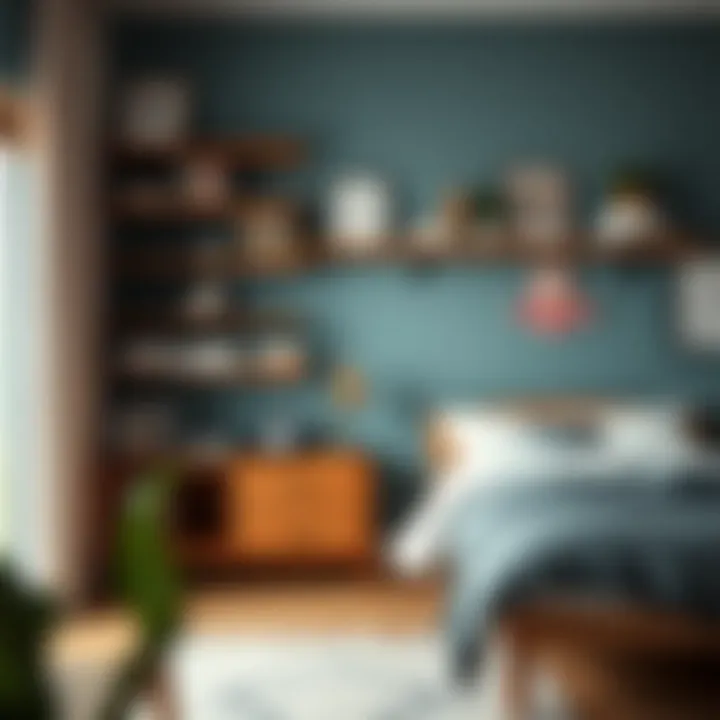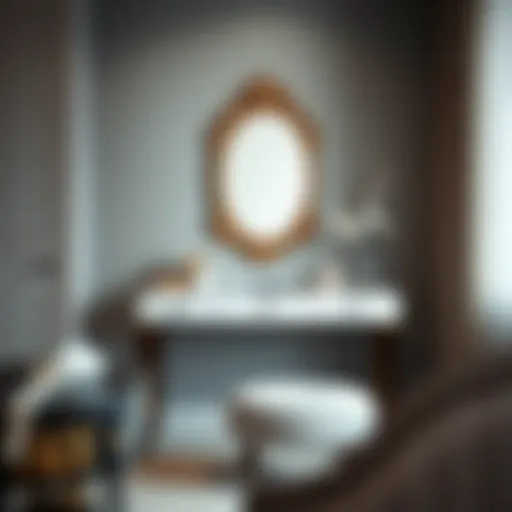Teen Bedroom Trends: Stylish and Functional Furniture


Intro
Creating the ideal bedroom for a teenager requires balancing style, functionality, and personal expression. Adolescence is a time of identity formation, and the bedroom is often a sanctuary where teens explore their tastes, interests, and needs. In this guide, we will delve into various aspects of teenage bedroom design, emphasizing how thoughtful furniture choices can mirror a young person's vibrant personality while serving practical purposes.
The right furniture can transform a cluttered space into a haven of creativity and relaxation.
As we chart this course, we will take a closer look at:
- Design Trends: Investigating contemporary styles and vintage inspirations.
- Material Innovations: Exploring sustainable materials and the advent of smart furniture technology.
By understanding the latest trends and innovations, homeowners, interior designers, and DIY enthusiasts can curate spaces that are not only aesthetically pleasing but also functional. It’s about crafting a sanctuary that accommodates study sessions, restful evenings, and social gatherings—a space where every detail reflects the dynamic life of a teenager.
Understanding Teenagers' Needs
Understanding teenagers' needs when designing their bedroom is crucial. This phase of life marks a period of rapid growth and transformation. A room isn’t just a space to sleep; it serves as a sanctuary for self-expression, a hub for socializing, and a productive environment for study. Meeting their desires for comfort, organization, and personalization can significantly impact their development and well-being.
When you take into account the unique requirements of teenagers, you're also tackling the psychological aspects of their environment. A well-designed room can foster creativity and promote a sense of autonomy. Furthermore, having a space that reflects their personality can aid in building self-confidence. It’s not just about slapping on a coat of paint or picking out flashy decor; it’s about crafting an environment that is conducive to their growth.
This exploration requires one to tread lightly through a multifaceted landscape of preferences and needs. Below, we dig deeper into the psychological underpinnings of space utilization and the delicate balance between functionality and aesthetics.
The Psychological Impact of Space
The design of a teenager's room plays a vital role in shaping their emotional state and cognitive productivity. Studies show that spaces that are cluttered or poorly organized can lead to increased levels of anxiety and stress. Conversely, a room that is thoughtfully arranged can provide a feeling of calm and stability.
- Personal Space: Just as a bird necessitates a nest, teenagers require their own sanctuary. They often seek privacy to navigate their thoughts and emotions. The layout, privacy considerations, and ambience can all play a role. For instance, using curtains or room dividers allows them to create a more isolated zone without feeling closed off.
- Color and Mood: Color psychology reveals that hues can elicit certain feelings. For example, calming blues may support relaxation, while bright yellows can stimulate creativity. Thus, it’s essential to consider how colors in the bedroom can align with their personality and emotional needs.
"A well-designed room can lead to a well-balanced mind."
In essence, capturing the emotional landscape of a teenager through thoughtful design choices makes their bedroom more than a mere collection of furniture.
Functionality vs. Aesthetics
In the realm of teen bedrooms, you face the eternal tug-of-war between functionality and aesthetics. This balance is crucial because functionality without aesthetic appeal can leave a room feeling sterile, while too much emphasis on looks can result in impracticality.
- Practical Furniture: A desk should not just look sleek; it must serve as an efficient workspace. For example, a desk with built-in storage keeps clutter at bay while offering space for school supplies and tech gadgets.
- Stylish Additions: Furniture pieces that blend aesthetic appeal with usefulness can be a game-changer. For instance, a stylish loft bed can free up floor space for play or study while still providing the comfort necessary for restful sleep.
- Adaptable Designs: Furniture that adapts to different activities can be incredibly valuable. Pieces like foldable chairs or convertible couches can transform a space from a study zone to a hangout area without sacrificing style or comfort.
Ultimately, the goal is to foster an environment that resonates both functionally and visually. The youth of today value self-expression, and thus a bedroom that marries practicality with artistic expression allows them to flourish.
In summary, creating a teenager's bedroom is an intricate process. It's not simply about adding a bed and a desk; it's about understanding their nuanced needs and crafting a space that harmonizes functionality with aesthetic desire. This understanding sets the groundwork for personalized solutions that resonate well with the youthful spirit.
Essential Furniture Pieces for Teen Bedrooms
When it comes to designing a teenager's bedroom, the importance of selecting the right furniture can't be overstated. This space serves as a refuge, a workspace, and oftentimes a social hub for them. Thus, the furniture must not only fit the aesthetics but also meet the practical needs of a young adult who is navigating through various activities, from studying to hanging out with friends. By considering the essential pieces of furniture, one can create an environment that fosters comfort and reflects individuality.
Beds: A Foundation for Comfort
Types of Beds
Choosing the right type of bed is fundamental to ensure good rest and comfort. When thinking about beds, one worth noting is the platform bed. Its minimalist design offers both aesthetic appeal and an essential sturdiness that could outlast teenage years. Unlike traditional box springs, platform beds support the mattress directly, thus offering vital space underneath for storage or decor. That said, if a more classic feel resonates with a teen’s style, a sleigh bed might be the way to go, with its graceful curved design that adds a touch of elegance. But, the choice also hinges on how much time they spend sleeping versus parenting their social calendar.
Size Considerations
One size definitely does not fit all when it comes to beds. Finding the right size is essential for maximizing comfort. Twin beds are perfect if space is tight, but they can feel cramped as teens grow, while full or queen beds offer ample room. The key consideration here is allowing enough room for activities beyond just sleeping. Having a larger bed can facilitate reading, lounging, or even small gatherings. However, the downside is of course more space usage, which could compromise their ability to have additional furniture pieces.
Convertible Options
Convertible beds can be a game changer, especially in smaller spaces. Think of Murphy beds that fold up against the wall when not in use, allowing for more floor space during the day. This flexibility is ideal for teens who also need to make space for studying or hanging out with friends. On the other hand, some convertible options might not offer as much comfort during the night as a standalone bed would, so weighing daytime utility against nighttime comfort is essential.
Desks: Study and Creativity Spaces
Space-Saving Solutions
A desk can make or break a study area, especially when it comes to using space wisely. Wall-mounted desks are perfect choices for cramped quarters; they fold away when not in use. This ensures that a teen's room can double as a place for work and leisure without overwhelming the space. However, they might lack the storage space that standalone desks offer, so every inch needs to be utilized well.


Desk Styles
There’s a diverse array of desk styles available, each catering to different tastes and needs. For instance, a Scandinavian-style desk offers clean lines and a lightweight aesthetic that fits well with the current minimalistic trend. Meanwhile, an industrial-style desk, made of heavy materials like metal and reclaimed wood, introduces a rugged feel. Choosing a desk style that's in line with the teen's personal taste can help make study sessions more enjoyable. But keep in mind that style shouldn't override function; a desk without enough workspace can turn into an unwelcome eye sore.
Ergonomics and Comfort
Never neglect comfort when picking out a desk! Ergonomics can mean the difference between thriving in schoolwork and back pain. Choosing an adjustable desk can ensure that it meets the teenager's height and posture, promoting better health in the long run. However, adjustable options may not always fit the aesthetic each teen desires, which makes for a fine balance to achieve.
Storage Solutions: Organizing Space
Closets and Wardrobes
Storage is paramount, and a well-organized closet or wardrobe can change a messy room into a peaceful sanctuary. Consider opting for wardrobes with customizable shelves or hanging areas that can adapt as the teen’s needs change. It promotes personal organization while retaining a clean look. However, if the closet space is limited, those bulky wardrobes might consume too much floor space.
Bookshelves and Display Units
Bookshelves can serve a dual purpose: showcasing books and displaying personal memorabilia. A tall, narrow bookshelf can help save space while adding visual interest. Customizable shelves can also be tweaked as needs evolve, allowing them to mix books with photos and decor. An important feature to mention is that cluttered display units can lead to visual chaos, so maintaining a clean look is crucial for overall harmony in the room.
Under-Bed Storage
Using under-bed storage can transform what is often wasted space into an organized solution. Storage bins that neatly slide under the bed can hold seasonal clothing, shoes, or even school supplies. This way, the room feels less cramped, and those items are within reach. However, one downside can be the quality of bins; flimsy ones might quickly fall apart, losing their functionality.
Seating: Comfort and Socializing
Diverse Seating Options
Seating isn’t just about functionality; it’s about creating a vibe. From sleek desk chairs to cozy accents, variety can cater to different activities. For example, a stylish gaming chair can complement a teen’s passion for gaming while offering the necessary support for prolonged usage. But on the other hand, opting for just one type of seating might limit usage scenarios.
Floor Seating
Floor seats can add a casual touch, allowing for more informal hangouts. Cushions or low swooping chairs can invite friends over to chill and make the room a social hotspot. Just remember, they might not be the best choice for extended study sessions, and comfort will vary significantly between options.
Bean Bags and Lounge Chairs
These soft, inviting pieces make for excellent additions to a teen's room. They come in tons of colors and sizes, allowing for a perfectly tailored fit to their unique styles. Furthermore, they are wonderfully transient; they can be moved easily around the room or even taken to parties. But, while they shine in chill-out moments, they might not provide the kind of back support desired for prolonged working hours.
Color Schemes and Themes
The choice of color schemes and themes in a teenager's bedroom serves not just an aesthetic purpose; it plays a crucial role in shaping the overall atmosphere, emotional well-being, and functional aspects of the space. For teenagers, a bedroom is more than just a place to sleep—it's a personal sanctuary where they explore their identities, unwind after long days, and engage in creative pursuits. Thus, selecting the right colors and themes can lead to a balanced, inviting space that caters to the multifaceted life of a teen.
Choosing the Right Palette
When deciding on the color palette, it’s essential to consider the psychological effects that colors have on mood and behavior. For instance, soft blues and greens can evoke a sense of calmness, making them ideal for relaxation areas. On the flip side, bold colors like reds or yellows could stimulate energy and creativity, which is beneficial for study spaces. Here are a few tips to guide the selection process:
- Consider Their Personality: Encourage the teen to voice their favorite colors and motivations. Knowing their preferences can lead to a more personalized space.
- Balance Warm and Cool: A mix of warm and cool tones can strike a harmonious balance, promoting a feeling of comfort while also making the space vibrant.
- Use Neutrals as a Base: Integrating neutral colors with pops of brighter hues can provide flexibility. Neutrals allow for easy updates and personalization without complete overhauls.
Themed Spaces
Themed designs can transform the mundane into the magical, allowing a reflection of interests and personality. Below are some popular approaches:
Minimalist Approaches
A minimalist approach focuses on simplicity, often characterized by clean lines and a decluttered look. The benefits of minimalism include a more peaceful environment that reduces distractions, which can be helpful in promoting focus and productivity for study times. Key characteristics include a palette of neutral colors, ample natural light, and storage solutions that keep the space open and airy. However, it’s essential to note that while minimalism promotes simplicity, it may lack the personal touch that some teens desire.
Eclectic Designs
Eclectic designs take a different route by embracing individuality. This approach allows for a mix of styles and colors, creating a unique visual narrative. The beauty of eclectic designs lies in their flexibility; they can evolve as a teenager's interests change. Incorporating vintage finds with contemporary pieces can make the room feel lived-in and loved. Still, with such a diverse mix, it’s crucial to maintain a cohesive theme, as an overabundance of contrasting elements can lead to chaos rather than harmony.
Nature-Inspired Themes
Nature-inspired themes bring the outdoors in, utilizing earth tones and organic materials. These designs often feature elements like botanical prints, wood finishes, and natural light to create a peaceful retreat. Not only do these spaces feel fresh and inviting, but they also foster a connection with nature that can be soothing for many teens. While these designs tend to promote environmental consciousness, it can sometimes limit color choices to those drawn from natural elements, which may not resonate with all teenagers' preferences.
"Colors, like features, follow the changes of the emotions." —Pablo Picasso
Ultimately, whether one opts for a minimalist ambiance, an eclectic mix, or a grounding nature-inspired vibe, the aim is to create a space that feels like home. When teenagers can find their rhythm in their room's colors and theme, they’re more likely to engage positively with their environment, whether for studying, socializing, or simply relaxing.


Incorporating Technology
As we delve into the realm of designing a teenager's bedroom, it becomes increasingly evident that the integration of technology is not merely a trend but a necessity. Today's adolescents are digital natives, and their living spaces must align with their lifestyle while adapting to their learning and social needs. Incorporating technology not only enhances the functionality of a bedroom but also elevates its aesthetic appeal. From interactive furniture to smart gadgets, there's a myriad of options to choose from, providing an environment that nurtures productivity and creativity.
Smart Furniture Solutions
Charging Stations
Charging stations have become a must-have in modern bedrooms. These are designed to keep gadgets powered up without the clutter of wires strewn all over. A well-placed charging station can offer easy access to charging devices right next to the bed or desk.
One major appeal of charging stations is their ability to charge multiple devices at once—think smartphones, tablets, and smartwatches. It is a beneficial choice in this context, especially because teenagers often possess several gadgets. Some charging stations even include wireless charging options, adding another layer of convenience.
However, it's vital to choose models that integrate well into the overall design of the room, as poorly placed or unsightly stations can detract from the aesthetics. The uniqueness of these charging stations lies in their adaptability, fitting into modern furniture pieces like nightstands or desks, providing not just utility but also complementing the room's style.
Smart Lighting
Next up is smart lighting, an essential component that significantly impacts the ambiance of a teenager's bedroom. From adjustable brightness to customizable colors, smart lighting can transform a room from a study zone into a cozy lounge area within seconds.
The charm of smart lighting is its integration with home automation systems, allowing teenagers to control the lights from their smartphones or voice assistants. This flexibility makes it a popular option among tech-savvy teens. Bright colors can stimulate energy and focus, while softer hues aid in relaxation and winding down, aligning perfectly with the various activities teenagers engage in—homework, gaming, socializing, or decompressing.
Nonetheless, it's important to remember that while smart bulbs might seem like a straightforward solution, the initial setup and potential compatibility issues with existing systems can pose challenges. The advantage is still significant; however, as they offer a modern touch that resonates with today's youth.
Integrated Audio Systems
When it comes to creating a vibrant atmosphere, integrated audio systems steal the show. They allow the personalization of soundscapes in the bedroom totally, from background study music to explosive game soundtracks.
The convenience of having speakers built into furniture—like desks or shelving—takes entertainment and productivity to another level. This feature not only saves space but also enhances the aesthetics, hiding messy wires and bulky equipment. Such systems are beneficial for those who love hosting friends, providing high-quality sound without cumbersome setups.
On the flip side, one must consider that the investment in high-quality systems can weigh heavy on a budget. It's a dilemma that requires balancing costs with desired sound quality. What sets these systems apart is their ability to be integrated seamlessly into the room while providing a rich audio experience that fits perfectly with the lifestyle of today’s teenagers.
Creating a Tech-Friendly Environment
Establishing a tech-friendly environment involves more than just individual gadgets or systems; it's about crafting a cohesive atmosphere where technology enhances the teenage experience. Consider incorporating modular furniture that accommodates tech accessories, ensuring that every aspect of the room serves a purpose.
- Wiring Management: Ensure that cables and chargers are organized and hidden to prevent any tangling or mess.
- Multi-Use Spaces: Designate areas for different activities—study zones should be distinct yet adaptable, while social spaces can incorporate technology for gaming or streaming.
- Accessibility: Make sure tech elements like outlets and charging areas are within easy reach to promote a smoother day-to-day flow.
Personalization and Expression
Creating a teenager's bedroom goes beyond mere functionality and style. It's fundamentally about expressing individuality and personal taste. During these formative years, many teens are discovering who they are, and their bedroom serves as both a sanctuary and a canvas for that exploration. Personalization allows them to curate a space that reflects their interests, hobbies, and aspirations. A well-expressed room can enhance emotional well-being, fostering a sense of ownership and comfort.
Selecting pieces that resonate with a teenager's preferences has a dual benefit. Not only does it provide them with a space they feel connected to, but it also encourages them to take responsibility for their environment. Consequently, personalization is not merely an aesthetic choice; it is a pivotal aspect that promotes creativity and self-discovery in their daily lives.
Customizable Furniture Options
Customizable furniture options are a game-changer for personalizing a teenager's bedroom. These pieces can adapt to evolving tastes and growing needs. For instance, a modular bed can transform from a single bed to a loft-style bed, accommodating varied activities like sleeping, studying, or even socializing. Similarly, desks that allow for interchangeable components can shift from a study station to a creative workspace.
The key characteristic of customizable furniture is its versatility. This adaptability means the furniture doesn’t just last through changing phases of adolescence. It often makes it easier to repurpose and rearrange, supporting both functionality and style, ensuring longevity in design choices. In this evolving stage of life, having the freedom to change their space can be particularly empowering for a teenager.
Incorporating Personal Touches
Art and Decor
Art and decor accents play a significant role in breathing life into a bedroom. They allow teens to infuse their personalities into their surroundings. Posters, artwork, and prints can resonate with their hobbies, interests, or favorite quotes. A well-placed work of art can set the tone of the room, whether it's vibrant, moody, or inspirational.
The benefit of using art and decor is twofold; firstly, it can promote a cozy and inviting atmosphere, and secondly, it encourages teens to express their individuality. Unique pieces or a personal gallery wall can help establish their identity and create pride in their space. However, decor can come with challenges, as trends can shift quickly, and constantly updating might lead to overwhelming clutter.
Photos and Memorabilia
Incorporating photos and memorabilia serves as a tangible reminder of cherished moments and experiences. Family images, snapshots with friends, or mementos from trips can craft a nostalgic ambiance. They have a unique way of making a room feel lived-in and special.
The cultural significance of displaying personal memory items starkly resonates with teenagers undergoing rapid change. These items serve as anchors, grounding them amid life's turmoil. However, it’s essential to curate wisely—selecting meaningful items over quantity can minimize clutter while maximizing sentiment.
DIY Projects
Engaging in DIY projects allows teenagers to take ownership of their design. Tasks like painting furniture or creating handmade decorations are not just fulfilling creative outlets; they can also be cost-effective ways to personalize their space. DIY projects can foster a sense of accomplishment and provide a unique result tailored to individual tastes.


The beauty of DIY lies in its exploration. Every project can serve as an experiment, leading to diverse interpretations of style and function. But it can also come with trials; not every project will turn out as envisioned. Planning and resourcefulness are critical for these endeavors to achieve the desired outcome.
"Personalization is more than just decoration—it's an integral part of shaping identity and fostering self-expression for teenagers."
In summary, when it comes to personalization and expression in a teenager's bedroom, integrating customizable furniture options, showcasing art, photos, and memorabilia, alongside embracing DIY projects enriches the space. These elements not only reflect their personality but also encourage emotional growth and confidence during a pivotal stage in their lives.
Accommodating Different Activities
Creating a teenager's bedroom is no small feat; it serves not just as a place to sleep but also as a multifunctional environment that supports various activities. A well-thought-out space that accommodates different activities is crucial to foster productivity, relaxation, and social engagement. Understanding what activities your teenager is involved in – whether it's studying, lounging with friends, or unwinding – helps you decide on the right furniture and layout. When a space caters to diverse functions, it can significantly enhance a teen’s daily experience, making it feel more welcoming and tailored to their needs.
Study and Work Areas
A designated study area is essential for any teenager. It boosts focus and productivity while providing a clear boundary for work amidst a chaotic schedule of school, hobbies, and social activities. The ideal workspace should include:
- A Desk with Ample Surface Area: A larger desk can hold books, a laptop, and stationery, offering ample room for multiple projects at once.
- Comfortable Ergonomic Chair: Since they might spend hours there, a chair that supports good posture can make a world of difference.
- Good Lighting: Natural light is great, but additional lighting, like desk lamps with adjustable brightness, ensures they don’t strain their eyes during late-night study sessions.
Having 'study zones' means teens can stay organized, and it makes a physical statement that learning is valued. Plus, with a bit of creativity, they could personalize their study area with vibrant stationery or inspiring decor.
Social Spaces
Teenagers are social creatures; they thrive on connection and camaraderie. Thus, designing a space where they can host friends is vital. Think about:
- Flexible Seating Options: Including comfortable seating like bean bags or a cozy sectional couch can make your teen's bedroom the go-to hangout spot.
- Multimedia Setup: A smart television or a good sound system could cater to movie nights or gaming sessions with friends.
- Social-Friendly Furniture: Consider furniture that can move around easily. Lightweight chairs or stools can easily be rearranged to suit group activities, encouraging interaction without feeling cramped.
These elements help craft a social hub, allowing teenagers to entertain friends and bond over shared activities, reinforcing community and support within their friend group.
Relaxation Zones
While engaging in social and academic activities is essential, relaxation holds equal importance. Creating a sanctuary within their bedroom for unwinding is key to mental well-being. Some crucial features include:
- Cozy Nook: A corner with cushions or soft throws can serve as a reading nook, ideal for lonesome afternoons or lazy weekends.
- Meditation or Fitness Space: An open area where teens can do yoga, meditate, or stretch, promotes relaxation and mindfulness practices.
- Soft Lighting Options: Implementing dimmable lights can set the mood for relaxation, whether it’s for reading a book or simply enjoying some peaceful moments.
By including relaxation zones, you cultivate a space that encourages teens to recharge both mentally and physically, making it much easier to tackle their busy lives.
Ultimately, a teenager's bedroom should embody a balanced approach that facilitates various aspects of their lives. This consideration not only aligns with their daily activities but also fosters an environment where they feel comfortable, confident, and in control.
Sustainability and Eco-Friendly Choices
As the world becomes increasingly aware of environmental issues, it's crucial to integrate sustainability into the process of designing a teenager's bedroom. Teenagers today are often more attuned to climate change and ecological impact than previous generations. They desire spaces that not only serve their functional needs but also reflect a commitment to sustainability. Choosing eco-friendly furniture options can have several benefits ranging from reducing the carbon footprint to promoting healthier indoor air quality.
The importance of considering sustainable choices during the furnishing process cannot be overstated. First and foremost, eco-friendly materials often come from renewable sources, which means they can be harvested without depleting the earth's resources. Moreover, many sustainable materials are less toxic than traditional options, ensuring that the air in a teenager's room is cleaner and safer. Environmental consciousness should also extend to appropriately managing waste by opting for furniture that can last longer or be repurposed.
Materials Matter
When it comes to selecting furniture, the types of materials used play a significant role in sustainability. Here are a few eco-friendly options to consider:
- Bamboo: This fast-growing grass is a fantastic alternative to hardwood. It’s strong, lightweight, and can be harvested without damaging the ecosystem.
- Reclaimed Wood: Furniture made from reclaimed wood not only looks charmingly rustic but also reduces the need for new timber, which contributes to deforestation.
- Recycled Metal: Items constructed from recycled metals are durable and require significantly less energy to produce compared to their new counterparts.
- Non-Toxic Finishes: Opting for products that use natural oils or water-based paints ensures fewer harmful chemicals are released into the room.
Using sustainable materials often translates into better durability. High-quality, eco-friendly furniture can withstand the wear and tear of a teenager's dynamic lifestyle, making it a wise investment.
Second-Hand and Repurposed Furniture
Another viable option for creating an environmentally friendly teenager's bedroom is exploring second-hand and repurposed furniture. This route offers both character and sustainability:
- Unique Finds: Vintage shops and online marketplaces are treasure troves of one-of-a-kind pieces, which adds a personalized touch to the decor.
- Economic Benefits: Buying second-hand can be more budget-friendly. Instead of splurging on new items, teenagers (and their parents) can find quality pieces at a fraction of the cost.
- DIY Opportunities: Purchasing used furniture can inspire creativity. Teens can also take on projects that involve sanding, painting, or reupholstering, fostering a sense of ownership over their space.
- Waste Reduction: By giving old furniture a new life, homeowners are actively participating in waste reduction efforts, diverting items from landfills.
"The act of repurposing not only minimizes waste but also taps into a level of creativity that can transform any space."
The End
Crafting the perfect teenager's bedroom encompasses a delicate balance between functionality and aesthetics. In recent years, the role that a bedroom plays has evolved significantly for teens; it is no longer just a place to sleep but a multifunctional space for studying, socializing, and personal growth. Offering insight into how to navigate this transformation is essential, as it reflects their evolving identities and needs.
The Future of Teen Bedroom Design
The future of teen bedroom design invites an adventurous mindset. As trends shift and styles evolve, it becomes vital to stay attuned to the preferences of the younger demographic. This requires considering not just the furniture pieces but also how each element integrates with their daily life.
- Technology Integration: The incorporation of smart furniture solutions, such as charging stations and integrated audio systems, aligns with how teens interact with technology today. Furniture that adapts to these needs becomes increasingly essential, enabling a seamless blend of study and leisure.
- Sustainable Choices: Eco-friendliness is no longer an afterthought. Teens are moving towards a lifestyle that prioritizes sustainability. Future designs may prominently feature sustainable materials and second-hand options. This not only resonates with their values but also highlights unique styles.
- Personalization: The burgeoning trend toward customized spaces showcases teenage individuality. Each teen should feel free to express themselves through their space, be it through art, DIY projects, or modular furniture that can evolve with them.
"A bedroom is not just a room; it's a canvas where teenagers paint their lives, interests, and personalities."
Understanding these trends provides the groundwork for creating a bedroom that responds to the needs of today's youth. Embracing these innovations will ensure that every teen's bedroom is more than a space; it transforms into a sanctuary that fosters creativity, relaxation, and growth.















